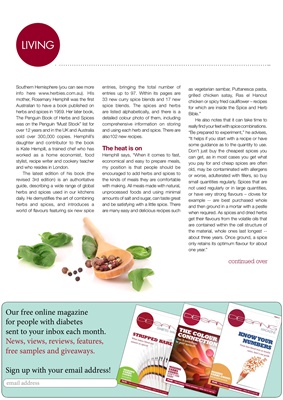
LIVINGLIVING
Southern Hemisphere (you can see more
info here www.herbies.com.au). HIs
mother, Rosemary Hemphill was the first
Australian to have a book published on
herbs and spices in 1959. Her later book,
The Penguin Book of Herbs and Spices
was on the Penguin 'Must Stock" list for
over 12 years and in the UK and Australia
sold over 300,000 copies. Hemphill's
daughter and contributor to the book
is Kate Hempill, a trained chef who has
worked as a home economist, food
stylist, recipe writer and cookery teacher
and who resides in London.
The latest edition of his book (the
revised 3rd edition) is an authoritative
guide, describing a wide range of global
herbs and spices used in our kitchens
daily. He demystifies the art of combining
herbs and spices, and introduces a
world of flavours featuring six new spice
entries, bringing the total number of
entries up to 97. Within its pages are
33 new curry spice blends and 17 new
spice blends. The spices and herbs
are listed alphabetically, and there is a
detailed colour photo of them, including
comprehensive information on storing
and using each herb and spice. There are
also102 new recipes.
The heat is on
Hemphill says, "When it comes to fast,
economical and easy to prepare meals,
my position is that people should be
encouraged to add herbs and spices to
the kinds of meals they are comfortable
with making. All meals made with natural,
unprocessed foods and using minimal
amounts of salt and sugar, can taste great
and be satisfying with a little spice. There
are many easy and delicious recipes such
as vegetarian sambar, Puttanesca pasta,
grilled chicken satay, Ras el Hanout
chicken or spicy fried cauliflower - recipes
for which are inside the Spice and Herb
Bible."
He also notes that it can take time to
really find your feet with spice combinations.
"Be prepared to experiment," he advises,
"It helps if you start with a recipe or have
some guidance as to the quantity to use.
Don't just buy the cheapest spices you
can get, as in most cases you get what
you pay for and cheap spices are often
old, may be contaminated with allergens
or worse, adulterated with fillers, so buy
small quantities regularly. Spices that are
not used regularly or in large quantities,
or have very strong flavours - cloves for
example -- are best purchased whole
and then ground in a mortar with a pestle
when required. As spices and dried herbs
get their flavours from the volatile oils that
are contained within the cell structure of
the material, whole ones last longest --
about three years. Once ground, a spice
only retains its optimum flavour for about
one year."
Our free online magazine
for people with diabetes
sent to your inbox each month.
News, views, reviews, features,
free samples and giveaways.
Sign up with your email address!
email address
continued over